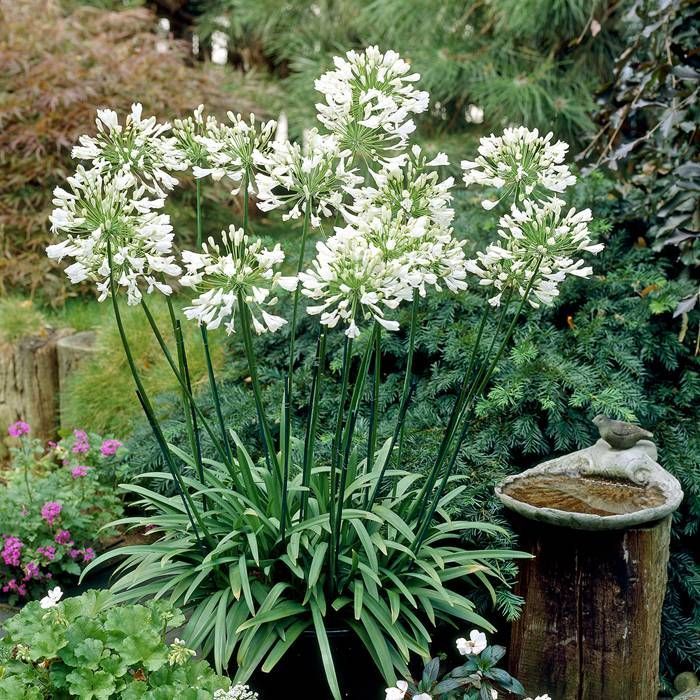Agapanthus Propagation: Tips for Expanding Your Plant Collection
Agapanthus Propagation: Tips for Expanding Your Plant Collection
Blog Article
Unleashing the Secret to Successful Agapanthus Farming: Advice for a Flourishing Garden
In the world of gardening, cultivating agapanthus effectively needs a strategic technique that incorporates various elements of plant care. By recognizing the subtleties of agapanthus growing, one can produce an environment where these plants flourish and flower perfectly.
Growing Agapanthus: Ideal Practices
When growing Agapanthus, appropriate dirt prep work is necessary for ensuring successful growth and development of these gorgeous blossoms. Agapanthus, typically called Lily of the Nile or African lily, grows in well-draining dirt with a somewhat acidic to neutral pH level - Agapanthus. Prior to growing, it is essential to modify heavy clay dirts with raw material such as compost or peat moss to boost drain and give vital nutrients for the plants
To plant Agapanthus, select a location that gets full sunlight to partial color, as this will advertise healthy and balanced development and abundant flowering. Dig a hole two times the diameter of the plant's root round and position the Agapanthus at the same deepness it was previously growing. Carefully backfill the hole with soil, pushing down strongly to eliminate any kind of air pockets around the origins.
Water the newly grown Agapanthus thoroughly and continue to maintain the soil evenly damp, especially throughout the plant's active growing season. Agapanthus. Applying a balanced fertilizer once a month can better support the plant's development and blooming. By following these finest practices for growing Agapanthus, you can create a sensational display screen of these exciting blossoms in your yard
Perfect Soil Conditions for Agapanthus
For ideal growth and blooming success of Agapanthus plants, guaranteeing the dirt conditions are excellent is important. Agapanthus favors dirt that is abundant in nutrients, so including a balanced plant food throughout the growing season can promote healthy development and vivid blossoms.

Watering and Feeding Tips
To guarantee healthy development and vibrant flowers, appropriate watering and fertilizing methods are important for successful Agapanthus growing. Agapanthus plants profit from normal watering, specifically throughout the expanding season.
When it pertains to feeding Agapanthus, a balanced fertilizer with equivalent components nitrogen, phosphorus, and potassium can be used in the springtime to promote healthy and balanced development and blooming. Slow-release plant foods are suitable for providing nutrients slowly over a prolonged period. look at this website Avoid over-fertilizing, as this can result in excessive vegetation development at the expense of flowers.
Furthermore, incorporating raw material like garden compost right into the soil can improve nutrient levels and improve soil framework, assisting in the overall health and wellness of the Agapanthus plants. By complying with these watering and feeding tips, garden enthusiasts can guarantee their Agapanthus plants grow and generate magnificent displays of blossoms.
Pruning and Deadheading Methods
Correct trimming and deadheading methods play a vital role in keeping the health and visual appeals of Agapanthus plants, complementing the essential practices of watering and fertilizing for effective cultivation. Trimming Agapanthus involves eliminating spent flower heads, dead or yellowing fallen leaves, and overall shaping of the plant to advertise better growth. Deadheading, the procedure of removing faded blossoms, not just enhances the plant's appearance but likewise urges additional blooming.
When deadheading Agapanthus, it is recommended to trim off the blossom stem at the base using sharp, clean shears. This procedure reroutes the plant's power from seed production back into root and vegetation growth, advertising a healthier and extra robust plant. Routine deadheading can prolong the flowering duration of Agapanthus and prevent self-seeding, which can bring about congestion.
In terms of pruning, Agapanthus usually gain from a light trim after blossoming to clean the plant and encourage fresh growth. Cutting down the invested flower stems and eliminating any type of dead or damaged vegetation aids preserve the plant's vigor and total appearance. Nonetheless, it is necessary to stay clear of reducing into the crown of the plant, as this can compromise its health and wellness.

Protecting Agapanthus From Vermins and Diseases
Implementing reliable parasite and disease administration methods is vital to guarding the health and vigor of Agapanthus plants in cultivation. One common insect that affects Agapanthus is the Agapanthus borer, a caterpillar that tunnels right into the plant, triggering damage to the flowers and fallen leaves.
In enhancement to parasites, Agapanthus are susceptible to conditions this website such as root rot and fungal fallen leave spots. These problems can usually be stopped by making sure proper drain and staying clear of overwatering. If indications of condition show up, affected components of the plant must be quickly gotten rid of to stop additional spread. Fungicides may also be utilized as a therapy measure, following the producer's directions thoroughly. By remaining cautious and dealing with bug and condition issues without delay, garden enthusiasts can aid their Agapanthus prosper and flourish.
:max_bytes(150000):strip_icc()/agapanthus-growing-guide-7368912_06ba-bf1fa268243b451387986fbd1e2433b3.jpg)
Verdict
Finally, successful growing of agapanthus calls for appropriate planting techniques, optimal dirt problems, ample watering and feeding, normal trimming and deadheading, and protection from pests and illness. By following these tricks and suggestions, garden enthusiasts can guarantee a prospering yard filled up with beautiful agapanthus flowers. Agapanthus. Bear in mind to preserve regular treatment and interest to detail to advertise the health and durability of these article spectacular plants
When growing Agapanthus, proper soil preparation is necessary for guaranteeing effective growth and advancement of these gorgeous blossoms.Water the newly planted Agapanthus thoroughly and proceed to keep the soil evenly wet, specifically throughout the plant's energetic growing season.For optimum growth and flowering success of Agapanthus plants, making sure the dirt problems are ideal is critical. When hair transplanting or growing Agapanthus, guarantee the soil is well-prepared to offer the required structure for the plants to establish themselves effectively. One common parasite that impacts Agapanthus is the Agapanthus borer, a caterpillar that tunnels into the plant, causing damages to the blossoms and leaves.
Report this page